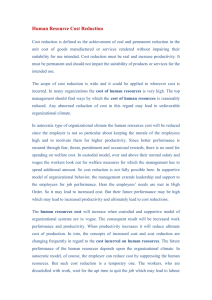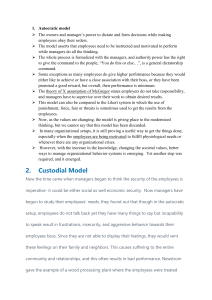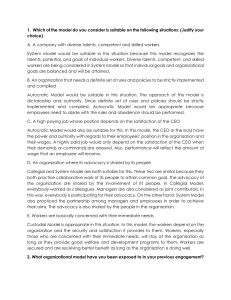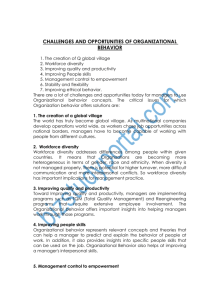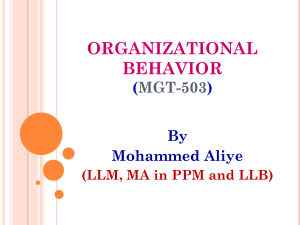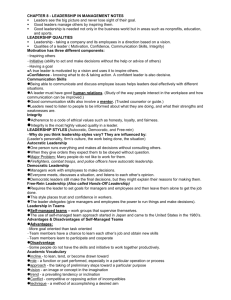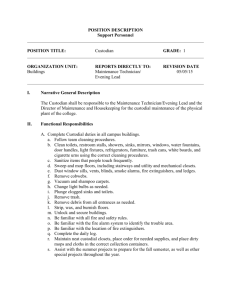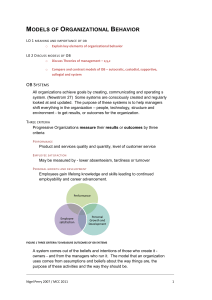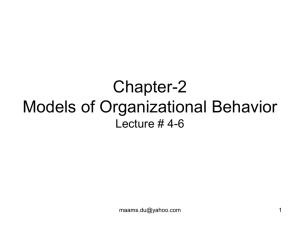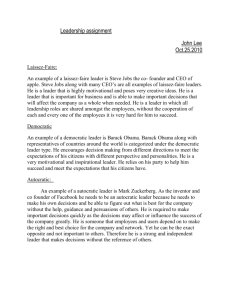ob-summary - Neelkanth
advertisement
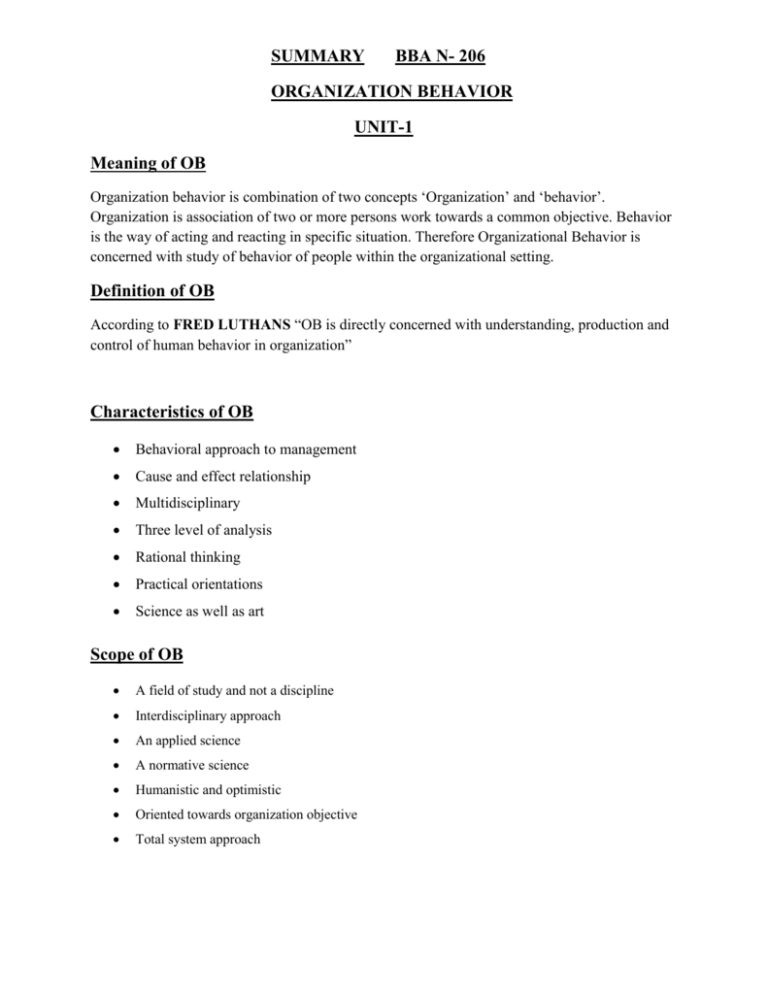
SUMMARY BBA N- 206 ORGANIZATION BEHAVIOR UNIT-1 Meaning of OB Organization behavior is combination of two concepts ‘Organization’ and ‘behavior’. Organization is association of two or more persons work towards a common objective. Behavior is the way of acting and reacting in specific situation. Therefore Organizational Behavior is concerned with study of behavior of people within the organizational setting. Definition of OB According to FRED LUTHANS “OB is directly concerned with understanding, production and control of human behavior in organization” Characteristics of OB Behavioral approach to management Cause and effect relationship Multidisciplinary Three level of analysis Rational thinking Practical orientations Science as well as art Scope of OB A field of study and not a discipline Interdisciplinary approach An applied science A normative science Humanistic and optimistic Oriented towards organization objective Total system approach Structure People Key Element Of OB Technology Importance of OB Motivation Leadership Communication Interpersonal relations Organizational climate Organization adaptation Basic Approach of OB Human relations approach – Focus on relation Contingency approach – Focus on situation and uncertainties Result oriented approach – Focus on achievement of results Systems approach – Focus on development of overall approach Environment Models of OB AUTOCRATIC CUSTODIAL SUPPORTIVE COLLEGIAL Basis Power Economic Resource Leadership Partnership Managerial Orientation Authority Money Support Teamwork Employee Orientation Employee Psychological Result Employee needs met Obedience Job performance Responsible behavior Dependence on boss Security and benefits Dependence on organization Participation Self discipline Subsistence security Status and recognition Selfactualization Minimum Passive cooperation Awakened drive Moderate enthusiasm Performance Result Challenges and Opportunities faced by OB Responsibility to Globalization Workforce diversity Improving quality and productivity Empowering people Working in networked organization Improving people skills Foundation of OB Individual behavior Whole person Caused behavior Human dignity Social system Mutuality if Interest Holistic approach Need for management Levels of Management Individual level It includes the following: 1) Personality 2) Intelligence 3) Perception 4) Learning 5) Attitude 6) Motivation Group Level It includes the following: 1) Group dynamics 2) Team building 3) Leadership 4) Communication 5) Conflict 6) Decision making Organization level It includes the following: 1) Organization culture 2) HR policies 3) Work stress 4) Organization change 5) Organization development Organizational Goals Official goal: They are general aims of organization expressed in charter, annual report or mission statement. Operative goals: Reflects the actual intention of organization. It includes the steps to be taken to achieve Organization purpose. Impact of Global and Cultural diversity Ensure senior management initiative as an opportunity for integration and learning. Ensure senior management commitment and accountability Communicate how diversity is important to overall functioning of business Emphasize the value of diversity to all employees. Engage workforce in teambuilding exercise Develop methods to evaluate the effectiveness of diversity management programs. Barriers to accepting diversity Prejudice- unjustified negative attitude towards a person based on his membership of particular group. Ethnocentrism- tendency to regard towards one’s own culture, nation or group as superior. Stereotypes- set of beliefs applied universally to all members Discrimination- barring of an individual from membership of an organization or from a job because of his membership of particular group. How to manage diversity? Increasing awareness Increasing diversity skills Cultural diversity Gender diversity OBJECTIVE TYPE QUESTIONS UNIT – 1 1. True/ False 1) A happy worker is a productive worker. 2) Organizations are more effective when they present conflicts among employees. 3) Employees perform better when they don’t experience stress. 2. Which of the following statement brings out the nature of OB better? a) Study of human behavior b) Study of organization c) Study of animals in lab d) Study of human behavior in organization 3. Which of the following is a correct statement? a) Human behavior is caused and not random. b) Human behavior tends to be abnormal all the time. c) People always exhibits psychological disorders. d) People tend to avoid behavior. 4. OB offers – a) Technical skills b) People skills c) Communication skills d) Wide knowledge 5. Match the following: A 1. 2. 3. 4. 5. Psychology Anthropology Sociology Social psychology Political science B 1. Study of individual and group within political environment 2. Study of group behavior 3. Study of Individual behavior 4. Study of Culture 5. Study of influence of people on one another Fill in the blanks 6. Organization Behavior is multi- ____________ approach. 7. OB is the study of ______________ at work. 8. Three levels of OB are _______________, __________________ and ___________________. 9. ________________ and __________________ are two types of organizational goals. 10. Globalization is a_______________ for organizations. 12. Write down the key elements of OB? 13. Define OB? 14. Give basic approaches of OB? 15. Match the following: A B 1. Human relation approach 1. Achievements of results 2. Contingency approach 2. Interpersonal relation 3. Result oriented approach 3. Development of overall system 4. Systems approach 4. Situations and uncertainties 16. Complete the following table: AUTOCRATIC CUSTODIAL SUPPORTIVE COLLEGIAL Basis Managerial orientation Employee orientation Employee psychological approach Employee needs met Performance result 17. Organizational effectiveness is achieved when: a) Organizations are in existence for a long time. b) Employees feel satisfied c) Organization produces good quality goods and services at reasonable cost, earn profit and satisfy all stakeholders. d) Organization grows in size and volume. Complete the sentences: 18. An organization is a __________system in which members try to achieve organizational goals. 19. Organizational behavior is directly concerned with understanding, ______________________________________________________________________. 20. Autocratic model depends on _______________. 21. Organization behavior represents interaction among ____________, ________________ and ______________. 22. Collegial model is a ____________ concept. 23. In supportive model, management direction is to ________________ the employees. 24. Custodial approach leads to employee’s dependence on ________________. 25. Employees are required to follow orders in ______________ model.
